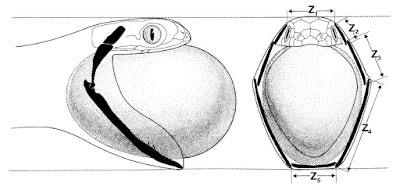La Performance (Performance)
In 1983, a paper by Stevan Arnold introduced the
morphology-performance-fitness paradigm (Arnold 1983), wherein variation in an
individual’s morphology (size, shape, structure) can be linked to natural
selection through its effects on performance. In this classic paper (cited nearly 4000 times, include a few times by me), Arnold gives the example of an egg-eating
snake: differences in the bone structure (morphology) affects egg-eating ability
(performance), which in turn influences growth, survivorship, and/or reproduction
(fitness). This paradigm has found wide application in a variety of organisms. For
example, Fabien has published a number of papers on the importance of slithering
and swimming performance in Tiger Snakes from Australia (see here).
In lizards, one of the most commonly applied measures of performance is sprint speed. This is especially important for many small lizard species that rely on quick bursts of speed to escape potential predators – how fast they can find a hole or crevice to hide means life-or-death. Many studies have measured the sprint speed of lizards in both lab and field settings (see many notable papers by Duncan Irschick and colleagues). Importantly, some studies show that lizards in their natural environments may not sprint at full capacity, thus making conclusions about sprint speed in the lab tenuous (see Irschick et al. 2005).
 |
| Diagram showing how variation in jaw bones can affect ability to ingest large prey -- in this case, eggs (from Arnold 1983.) |
 |
| Path diagram showing the relationships among morphology, performance, and fitness (from Arnold 1983.) |
In lizards, one of the most commonly applied measures of performance is sprint speed. This is especially important for many small lizard species that rely on quick bursts of speed to escape potential predators – how fast they can find a hole or crevice to hide means life-or-death. Many studies have measured the sprint speed of lizards in both lab and field settings (see many notable papers by Duncan Irschick and colleagues). Importantly, some studies show that lizards in their natural environments may not sprint at full capacity, thus making conclusions about sprint speed in the lab tenuous (see Irschick et al. 2005).
Podarcis muralis
could very well be the poster child for a small lizard that quickly flees into
rock crevices when faced with a threat. Around here, lizards can be found
prowling nearly every stone wall (and there are a lot of stone walls in southern
France!). Since sprint speed is an important ecological trait and one that we
expect to be impacted by oxygen availability, we are working on protocols to
measure sprint speed in our lizards. As is evident any time one attempts to
catch a lizard by hand, these lizards are FAST! In fact, some reach speeds of
nearly 10 km/h!
Slow-motion video of a lizard running down our lizard 'racetrack'. Concept and video by James Gangloff.
Past studies have demonstrated that these quick bursts of energy are largely fueled by anaerobic respiration (e.g., Bennett 1972). Given our interest in how lower levels of oxygen availability might affect lizard physiology and performance, we don’t necessarily expect hypoxia to reduce maximum sprint speed. What we do expect, though, is that endurance will be reduced and the ability to recover from this intense activity will be prolonged. So, we are running lizards multiple times to test how their performance declines over time. We will also measure their metabolic rates (oxygen consumption/carbon dioxide production) after they are exhausted to compare recovery times between lizards at different altitudes.
Last week, we conducted a pilot study in which we ran
lizards down a meter-long track ten times, with a 60 s break between each
trial. With this protocol, we did not observe any indication that lizards were
slowing down.
This week, we modified the protocol to give lizards only 30 s to recover between trials. With this shorter time, we observed a clear decrease in speed over the ten trials. We conducted this pilot study here in Moulis (at about 400 m above sea level), so we expect that at higher elevations (where there is less available oxygen), the effect will be even more dramatic. We’ll soon find out!




Comments
Post a Comment